light VAUXHALL ADAM 2015 Repair Manual
[x] Cancel search | Manufacturer: VAUXHALL, Model Year: 2015, Model line: ADAM, Model: VAUXHALL ADAM 2015Pages: 225, PDF Size: 6.81 MB
Page 175 of 225

Vehicle care173
No.Circuit35–36–37rear wiper38cigarette lighter39–40–Vehicle toolsTools
Vehicles with tyre repair kit
Some tools and the towing eye are
located together with the tyre repair
kit in a tool box in the load
compartment below the floor cover.
On version with storage box, remove
box first 3 64.
On versions with rear carrier system
or liquid gas engine, the tools are
located together with the towing eye
and tyre repair kit in a suitcase, fixed
with a strap at the left sidewall in the
load compartment.
Page 180 of 225
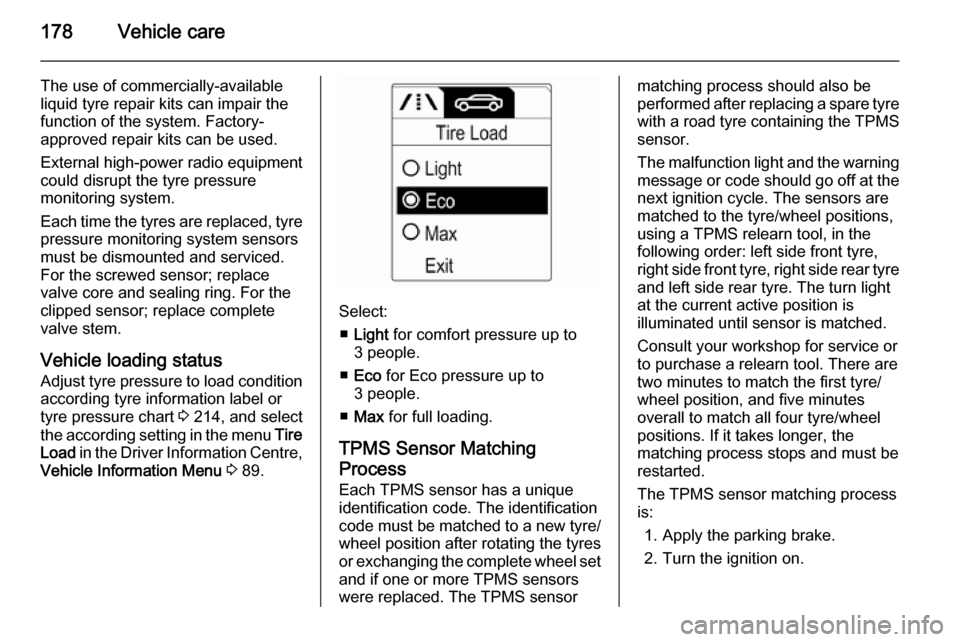
178Vehicle care
The use of commercially-availableliquid tyre repair kits can impair the
function of the system. Factory-
approved repair kits can be used.
External high-power radio equipment
could disrupt the tyre pressure
monitoring system.
Each time the tyres are replaced, tyre pressure monitoring system sensors
must be dismounted and serviced.
For the screwed sensor; replace
valve core and sealing ring. For the
clipped sensor; replace complete
valve stem.
Vehicle loading status Adjust tyre pressure to load condition according tyre information label or
tyre pressure chart 3 214, and select
the according setting in the menu Tire
Load in the Driver Information Centre,
Vehicle Information Menu 3 89.
Select:
■ Light for comfort pressure up to
3 people.
■ Eco for Eco pressure up to
3 people.
■ Max for full loading.
TPMS Sensor Matching
Process
Each TPMS sensor has a unique
identification code. The identification
code must be matched to a new tyre/
wheel position after rotating the tyres
or exchanging the complete wheel set
and if one or more TPMS sensors
were replaced. The TPMS sensor
matching process should also be
performed after replacing a spare tyre with a road tyre containing the TPMS
sensor.
The malfunction light and the warning
message or code should go off at the
next ignition cycle. The sensors are
matched to the tyre/wheel positions,
using a TPMS relearn tool, in the
following order: left side front tyre,
right side front tyre, right side rear tyre and left side rear tyre. The turn light
at the current active position is
illuminated until sensor is matched.
Consult your workshop for service or
to purchase a relearn tool. There are
two minutes to match the first tyre/
wheel position, and five minutes
overall to match all four tyre/wheel
positions. If it takes longer, the
matching process stops and must be
restarted.
The TPMS sensor matching process is:
1. Apply the parking brake.
2. Turn the ignition on.
Page 185 of 225
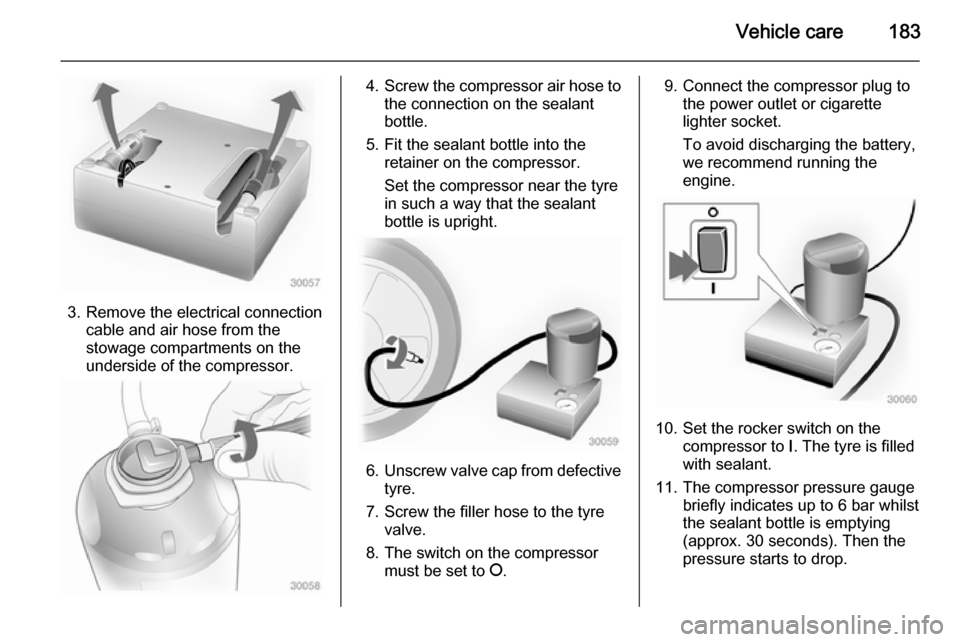
Vehicle care183
3. Remove the electrical connectioncable and air hose from the
stowage compartments on the
underside of the compressor.
4. Screw the compressor air hose to
the connection on the sealant
bottle.
5. Fit the sealant bottle into the retainer on the compressor.
Set the compressor near the tyre
in such a way that the sealant
bottle is upright.
6. Unscrew valve cap from defective
tyre.
7. Screw the filler hose to the tyre valve.
8. The switch on the compressor must be set to J.
9. Connect the compressor plug to
the power outlet or cigarette
lighter socket.
To avoid discharging the battery,
we recommend running the
engine.
10. Set the rocker switch on the compressor to I. The tyre is filled
with sealant.
11. The compressor pressure gauge briefly indicates up to 6 bar whilstthe sealant bottle is emptying
(approx. 30 seconds). Then the
pressure starts to drop.
Page 191 of 225
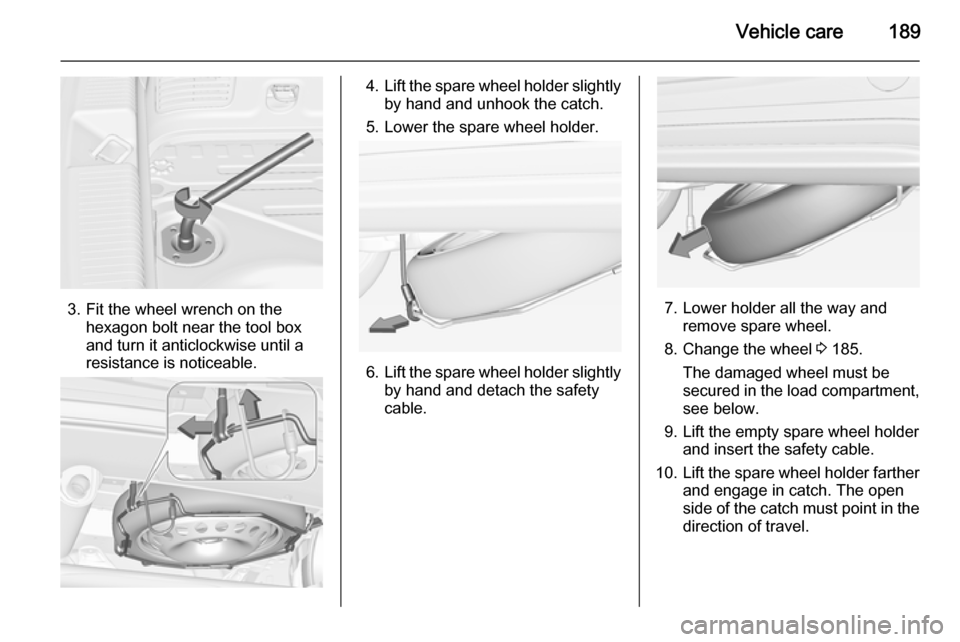
Vehicle care189
3. Fit the wheel wrench on thehexagon bolt near the tool box
and turn it anticlockwise until a
resistance is noticeable.
4. Lift the spare wheel holder slightly
by hand and unhook the catch.
5. Lower the spare wheel holder.
6. Lift the spare wheel holder slightly
by hand and detach the safety
cable.
7. Lower holder all the way and remove spare wheel.
8. Change the wheel 3 185.
The damaged wheel must be
secured in the load compartment,
see below.
9. Lift the empty spare wheel holder and insert the safety cable.
10. Lift the spare wheel holder farther
and engage in catch. The open
side of the catch must point in the direction of travel.
Page 196 of 225
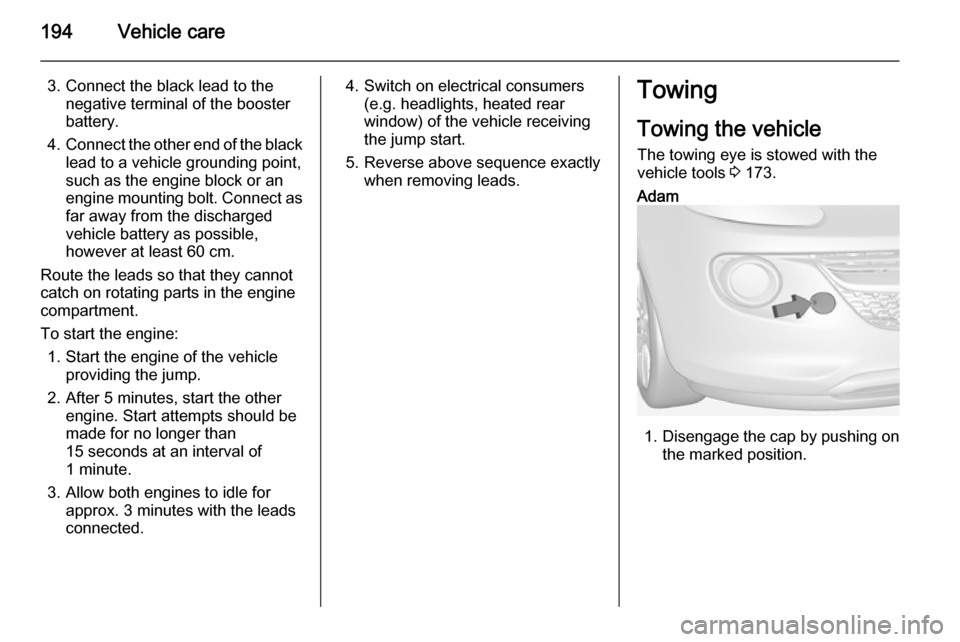
194Vehicle care
3. Connect the black lead to thenegative terminal of the booster
battery.
4. Connect the other end of the black
lead to a vehicle grounding point,
such as the engine block or an
engine mounting bolt. Connect as far away from the discharged
vehicle battery as possible,
however at least 60 cm.
Route the leads so that they cannot
catch on rotating parts in the engine
compartment.
To start the engine: 1. Start the engine of the vehicle providing the jump.
2. After 5 minutes, start the other engine. Start attempts should be
made for no longer than
15 seconds at an interval of 1 minute.
3. Allow both engines to idle for approx. 3 minutes with the leads
connected.4. Switch on electrical consumers (e.g. headlights, heated rear
window) of the vehicle receiving
the jump start.
5. Reverse above sequence exactly when removing leads.Towing
Towing the vehicle The towing eye is stowed with thevehicle tools 3 173.Adam
1. Disengage the cap by pushing on
the marked position.
Page 197 of 225
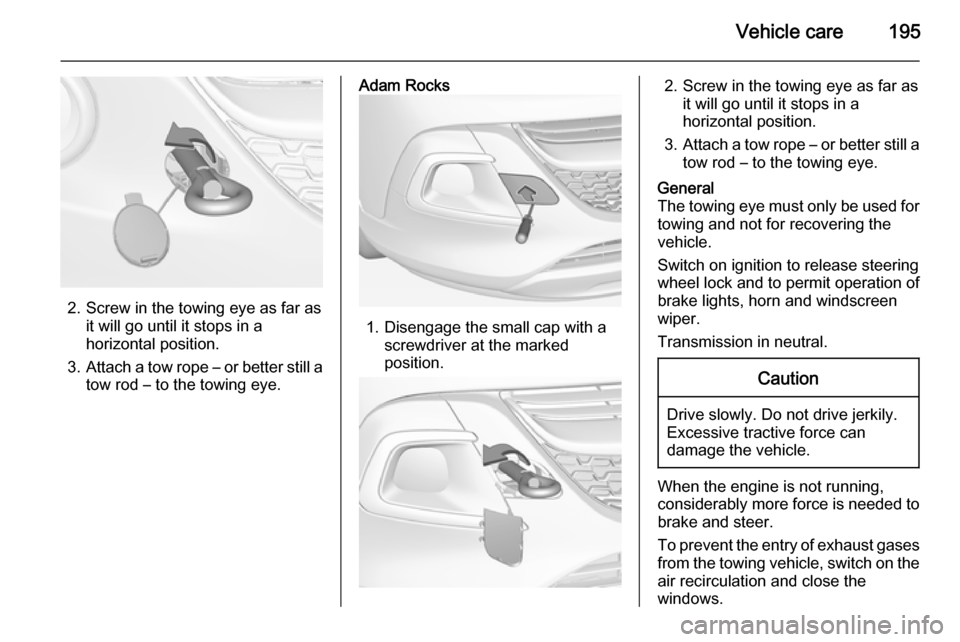
Vehicle care195
2. Screw in the towing eye as far asit will go until it stops in a
horizontal position.
3. Attach a tow rope – or better still a
tow rod – to the towing eye.
Adam Rocks
1. Disengage the small cap with a screwdriver at the marked
position.
2. Screw in the towing eye as far as it will go until it stops in a
horizontal position.
3. Attach a tow rope – or better still a
tow rod – to the towing eye.General
The towing eye must only be used for
towing and not for recovering the
vehicle.
Switch on ignition to release steering
wheel lock and to permit operation of
brake lights, horn and windscreen
wiper.
Transmission in neutral.Caution
Drive slowly. Do not drive jerkily.
Excessive tractive force can
damage the vehicle.
When the engine is not running,
considerably more force is needed to
brake and steer.
To prevent the entry of exhaust gases from the towing vehicle, switch on the
air recirculation and close the
windows.
Page 200 of 225

198Vehicle careCaution
Always use a cleaning agent with
a pH value of 4 to 9.
Do not use cleaning agents on hot surfaces.
Have the door hinges of all doors
greased by a workshop.
Do not clean the engine compartment with a steam-jet or high-pressure jet
cleaner.
Thoroughly rinse and leather-off the vehicle. Rinse leather frequently. Use
separate leathers for painted and
glass surfaces: remnants of wax on
the windows will impair vision.
Exterior lights
Headlight and other light covers are
made of plastic. Do not use any
abrasive or caustic agents, do not use an ice scraper, and do not clean them
dry.
Polishing and waxing
Wax painted parts of the vehicle
regularly (at the latest when water no
longer beads). Otherwise, the
paintwork will dry out.
The foldable sunroof must not be
polished or waxed. When using
automatic car washes, select a
programme without wax additives.
Polishing is necessary only if the paint
has become dull or if solid deposits
have become attached to it.
Paintwork polish with silicone forms a
protective film, making waxing
unnecessary.
Unpainted plastic body parts must not be treated with wax or polishing
agents.
Matt filmed body parts or decor tapes must not be polished, to avoid
gleaming. Do not use hot wax
programmes in automatic car washes if the vehicle is equipped with these
parts.Matt painted decor parts, e.g. mirror
housing cover, must not be polished. Otherwise these parts would become
agleam or the colour would be
dissolved.
Windows and windscreen wiper blades
Use a soft lint-free cloth or chamois
leather together with window cleaner and insect remover.
When cleaning the rear window from
inside, always wipe in parallel to the
heating element to prevent damage.
For mechanical removal of ice, use a
sharp-edged ice scraper. Press the
scraper firmly against the glass so
that no dirt can get under it and
scratch the glass.
Clean smearing wiper blades with a
soft cloth and window cleaner.
Page 202 of 225
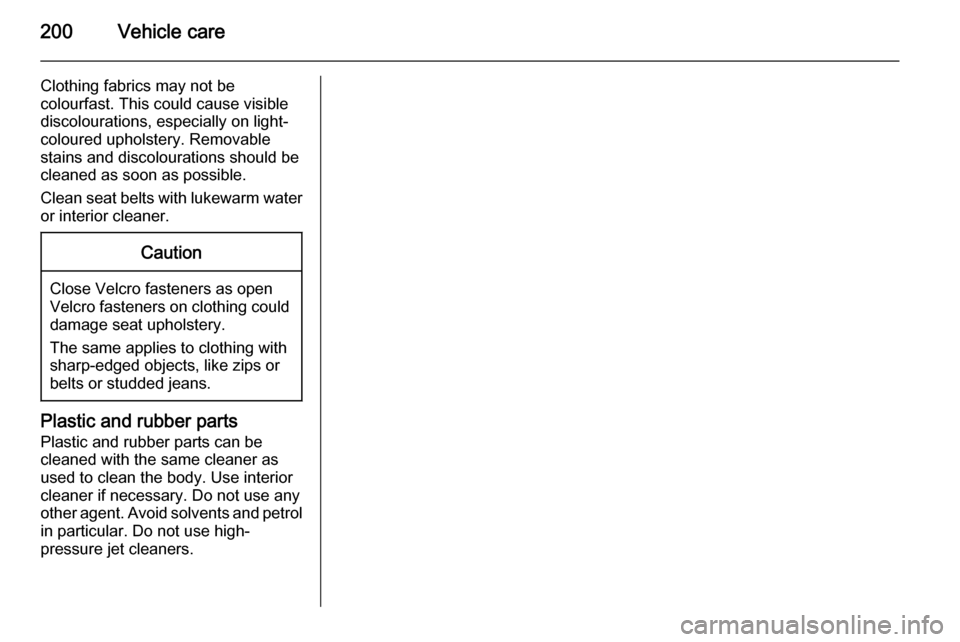
200Vehicle care
Clothing fabrics may not be
colourfast. This could cause visible discolourations, especially on light-
coloured upholstery. Removable
stains and discolourations should be
cleaned as soon as possible.
Clean seat belts with lukewarm water or interior cleaner.Caution
Close Velcro fasteners as open
Velcro fasteners on clothing could damage seat upholstery.
The same applies to clothing with
sharp-edged objects, like zips or
belts or studded jeans.
Plastic and rubber parts
Plastic and rubber parts can be
cleaned with the same cleaner as
used to clean the body. Use interior cleaner if necessary. Do not use any
other agent. Avoid solvents and petrol in particular. Do not use high-
pressure jet cleaners.
Page 220 of 225

218IndexAAccessories and vehicle modifications .......................... 152
Adjustable air vents ...................119
Airbag and belt tensioners ...........85
Airbag deactivation ................44, 85
Airbag label................................... 39 Airbag system .............................. 39
Air conditioning regular operation ................................ 120
Air conditioning system .............. 112
Air intake .................................... 119
Air vents...................................... 119
Antilock brake system ................ 127
Antilock brake system (ABS) .......86
Anti-theft alarm system ................25
Anti-theft locking system .............. 25
Appearance care ........................197
Ashtrays ....................................... 78
Automatic anti-dazzle ..................28
Automatic light control ...............104
Automatic locking ........................23
B Battery discharge protection ......110
Battery voltage ............................. 98
Belts.............................................. 36
Bicycle rack .................................. 54
Bonnet ....................................... 154Brake and clutch fluid.................202
Brake and clutch system .............86
Brake assist ............................... 129
Brake fluid .................................. 156
Brakes ............................... 127, 156
Breakdown.................................. 194
Bulb replacement ....................... 159
C Capacities .................................. 213
Car Pass ...................................... 19
Catalytic converter .....................126
Central locking system ................21
Changing tyre and wheel size ...180
Charging system .......................... 85
Child restraint installation locations ................................... 47
Child restraints.............................. 45
Child restraint systems ................45
Cigarette lighter ........................... 78
City mode ................................... 131
Climate control ............................. 15
Climate control systems .............111
Clock ............................................ 76
Code ............................................. 96
Colour-Info-Display .......................94
Control indicators.......................... 82
Control of the vehicle .................121
Controls ........................................ 71
Convex shape .............................. 27
Page 221 of 225

219
Coolant and antifreeze...............202
Cruise control ...................... 88, 132
Cupholders .................................. 52
Curtain airbag system .................. 43
D Danger, Warnings and Cautions ...4
Daytime running lights ...............105
Declaration of conformity ............215
Door open .................................... 89
Doors ............................................ 24
Driver assistance systems ..........132
Driver Information Centre .............89
Driving hints ................................ 121
E
Electric adjustment ......................27
Electrical system......................... 168
Electronic climate control system 114
Electronic Stability Control.......... 130
Electronic Stability Control and Traction Control system ............87
End-of-life vehicle recovery .......153
Engine compartment fuse box ...169
Engine coolant ........................... 155
Engine coolant temperature gauge ....................................... 80
Engine data ............................... 209
Engine exhaust .......................... 126
Engine identification ...................205Engine oil ................... 154, 202, 206
Engine oil pressure ......................88
Entry lighting .............................. 109
Event data recorders ..................216
Exit lighting ................................ 109
Exterior care .............................. 197
Exterior light ................................. 88
Exterior lighting ....................12, 103
Exterior mirrors ............................. 27
F
First aid ......................................... 68
First aid kit ................................... 68
Fixed air vents ........................... 119
Flex-Fix system ............................ 54
Folding mirrors ............................. 27
Front airbag system .....................42
Front seats.................................... 33
Front storage ................................ 53
Front turn signal lights ...............162
Fuel............................................. 146
Fuel consumption - CO 2-
Emissions ............................... 151
Fuel for liquid gas operation .......146
Fuel for petrol engines ...............146
Fuel gauge ................................... 80
Fuel selector ................................ 80
Fuses ......................................... 168G
Gauges ......................................... 79
Glass panel .................................. 31
Glovebox ..................................... 52
Graphic-Info-Display .....................95
H Halogen headlights ....................159
Hand brake ......................... 127, 128
Hazard warning flashers ............105
Headlight flash ........................... 104
Headlight range adjustment ......105
Headlights................................... 103
Headlights when driving abroad 105
Head restraint adjustment .............8
Head restraints ............................ 32
Heated mirrors ............................. 27
Heated rear window ..................... 30
Heated steering wheel .................72
Heating ........................................ 36
Heating and ventilation system . 111
High beam ........................... 88, 104
Hill start assist ........................... 129
Horn ....................................... 13, 72
I
Identification plate .....................205
Ignition switch positions .............122
Immobiliser ............................ 26, 88
Indicators ...................................... 79